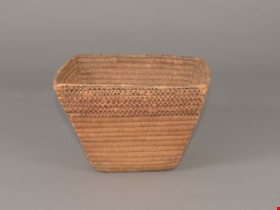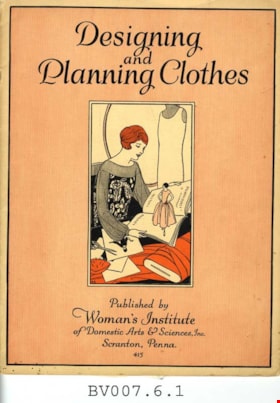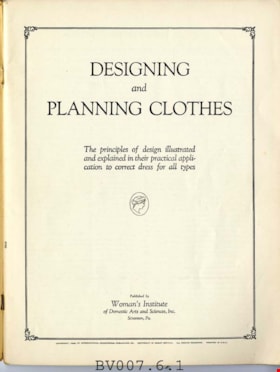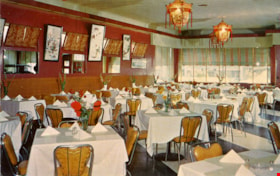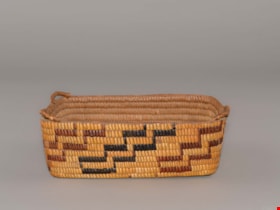Narrow Results By
Subject
- Adornment - Lapel Pins 4
- Advertising Medium 2
- Advertising Medium - Signs and Signboards 1
- Buildings - Civic - Museums 2
- Buildings - Commercial - Restaurants 1
- Buildings - Commercial - Stores 1
- Celebrations - Centennials 2
- Ceremonies 1
- Ceremonies - Weddings 1
- Clothing 200
- Clothing - Accessory 43
- Clothing - Costumes 126
Person / Organization
- Air Raid Precautions (A.R.P.) 1
- Bailey, Joan 8
- Bayntun, Charmaine "Sherrie" Yanko 2
- Bridge Studios 1
- British Columbia Corrections Service 2
- British Columbia Electric Railway Company 3
- British Columbia Gaol Service 1
- British Columbia Provincial Police 3
- Burnaby Centennial '71 Committee 1
- Burnaby Municipal Police 1
- Burnaby North High School 1
- Burnaby Public Library 1
berry basket
https://search.heritageburnaby.ca/link/museumartifact27527
- Repository
- Burnaby Village Museum
- Accession Code
- HV974.119.1
- Description
- Trapezoidal shaped, coiled cedar root basket with cedar slat foundation. Finished with an overcast rim with root foundation. Design elements missing from one side of the basket, which is uncommon but has been seen on cradles from the Mount Currie area (Interior Salish: Lil'wat). It was perhaps the side that rests on the wearer's back. Steeply angled sides.
- Coast Salish: Sḵwx̱wú7mesh? Interior Salish: Stl’atl’imx: Lil’wat?
- Object History
- The donor reported that the baskets were traded in the early 1920s for clothes by the donor's mother, who lived in North Vancouver. Her mother told her the "Capilano Indians" used to go door to door with their baskets in North Vancouver.
- Design elements missing from one side of the basket – possibly the side that would have rested against the owner’s back.
- Steeply angled sides keep berries from crushing those at bottom of basket. Work baskets have sides that are more rounded.
- Baskets like these were used with a woven tumpline (wool strap) that was worn against the forehead, while basket was carried on back.
- Country Made
- Canada
- Province Made
- British Columbia
- Culture
- Stl’atl’imx
Images
Documents
Designing and planning clothes : the principles of design illustrated and explained in their practical application to correct dress for all types
https://search.heritageburnaby.ca/link/museumlibrary4987
- Repository
- Burnaby Village Museum
- Collection
- Special Collection
- Material Type
- Textual Record
- Accession Code
- BV007.6.1
- Call Number
- 646 WOM
- Place of Publication
- Scranton, Pa.
- Publisher
- Woman's Institute of Domestic Arts and Sciences
- Publication Date
- c1925
- Physical Description
- 55 p. : ill. : 30 cm.
- Library Subject (LOC)
- Dressmaking--Study and teaching
- Dressmaking
- Dresses
- Fashion design
- Subjects
- Documentary Artifacts - Magazines
- Object History
- Home sewing course used by Burnaby residents in the 1920's
- Notes
- "415" -- Cover
Images
postcard
https://search.heritageburnaby.ca/link/museumartifact89212
- Repository
- Burnaby Village Museum
- Accession Code
- BV018.20.4
- Description
- postcard; color lithographed scene of Second Avenue in Seattle, Washington. A sign says "The Gateway to Alaska, Seattle, Washington". There are trams and people in Edwardian clothes on the street, there's a horse and buggy and cars on the road. The back of the postcard addressed to Miss M. George. Postcard published by Trattner Post Card Co., Seattle, Washington. Cancelled in Seattle, Washington, Terminal Station on July 25, 1917 at 10am. "Rainier National Park opens June 15". Postcard addressed to "Miss M. George / c/o National Drug / Vancouver / B.C." Handwritten in ink: "July 23 / Dear Miss George: Am sure in some lively place, not like N.V. Will see you again before long. / Budd"
- Object History
- Wilhelmina (Mina) George was the second female pharmacist in BC and ran the West Burnaby Pharmacy.
- Elsie Impett (later MacDonald) was born in 1902 in England. Her family setted at Fenwick Avenue, Burnaby. She worked as a clerk and married James MacDonald in 1923 in New Westminster.
- Classification
- Written Communication T&E - - Writing Media
- Object Term
- Postcard
- Measurements
- L: 19.5 cm W: 18.5 cm
Images
postcard
https://search.heritageburnaby.ca/link/museumartifact90986
- Repository
- Burnaby Village Museum
- Accession Code
- BV021.12.1
- Description
- Postcard: horizontal glossy colour postcard of Golden Dragon Resturant. Shows image of interior dining room with red and gold walls, laterns, tables with white table cloths. yellow chairs and a stripped black and white floor. On reservse in blue print: , "GOLDEN DRAGON" "3991 KINGSWAY" "BURNABY, B.C." "Phone: DExter 5100" "If you are not familiar with Chinese Foods let our Experts make suggestions and explain the traditions of eating that is famous throughout the world."; at bottom, "DINE and DANCE Every FRIDAY & SATURDAY"; line down centre; at right,"POST CARD" "ADDRESS"; at upper right, "STAMP"; unused; ca.1950s
- Object History
- Postcard from the Golden Dragon Resturant which served Chinese-Canadian food. Their grand opening was September 2, 1950. The community staple was known for its neon dragon sign that advertised “Chop Suey”. One side of the kitchen served Chinese foods, while another served Canadian dishes. Chinese cuisine such as rice would be served with chopsticks, while steaks, a more western dish, would be served with knife and fork. Advertisements from the resturant and meeting notices were found in local newspapers from 1950 to 1957. The establishment was not listed in the 1966 Great Vancouver Cross-Cross Directory.
- Classification
- Written Communication T&E - - Writing Media
- Object Term
- Postcard
- Marks/Labels
- Made in Canada by Grant-Mann Lithographers LTD. "Color Card" Division, Vancouver, British Columbia.
- Measurements
- 14cm wide x 9cm high
- Subjects
- Souvenirs
- Persons - Chinese Canadians
- Food Service Tools and Equipment
- Documentary Artifacts - Postcards
- Buildings - Commercial - Restaurants
- Historic Neighbourhood
- Central Park (Historic Neighbourhood)
- Planning Study Area
- Garden Village Area
Images
Trudi Tuomi subseries
https://search.heritageburnaby.ca/link/archivedescription126
- Repository
- City of Burnaby Archives
- Date
- [between 1937 and 1945]-1996
- Collection/Fonds
- Burnaby Historical Society fonds
- Description Level
- Subseries
- Physical Description
- 1 file of textual records and 5 photographs
- Scope and Content
- Subseries consists of photographs of the squatter community known as Crabtown that ran along the Burrard Inlet, accompanied by articles about growing up in that community.
- Repository
- City of Burnaby Archives
- Date
- [between 1937 and 1945]-1996
- Collection/Fonds
- Burnaby Historical Society fonds
- Subseries
- Trudi Tuomi subseries
- Physical Description
- 1 file of textual records and 5 photographs
- Description Level
- Subseries
- Accession Number
- BHS1996-20
- Scope and Content
- Subseries consists of photographs of the squatter community known as Crabtown that ran along the Burrard Inlet, accompanied by articles about growing up in that community.
- History
- Gustav and Aune Rintanen came to Vancouver from a mixed farm on the prairies in 1936 with the hopes of finding employment. The couple had two children: nine year old Aili (later Topalian) and eight year old Trudi (later Tuomi), when they moved to a “squatters shack” at North Burnaby’s waterfront Crabtown community in 1937. They paid 50 dollars for their two-room cabin, which was built on a platform and supported by pilings. Though the squatters’ homes that ran along the Inlet were commonly referred to as shacks and Crabtown a slum, in reality they were very neatly kept homes in a community. Crabtown residents rallied together to build a water supply system and trails up the steep bluff with stairs and banisters so children could go to school safely. Before Gustav found a job, he “busied himself with fixing up the place”: building a new chimney, railing, wood shed, clothes line and sauna for his family. By 1940, he was working at the mill near Windermere pool (now New Brighton Park). Aune worked as a dishwasher and prep cook at Ye Olde English Fish and Chips in downtown Vancouver. In 1946, they sold the cabin for two hundred dollars and moved to a small house. All Crabtown squatters were eventually evicted in 1959.
- Media Type
- Textual Record
- Photograph
- Creator
- Tuomi, Trudi Rintanen
- Notes
- Title based on contents and creator of subseries
- PC337, MSS144
work basket
https://search.heritageburnaby.ca/link/museumartifact27528
- Repository
- Burnaby Village Museum
- Accession Code
- HV974.119.2
- Description
- Rectangular coiled cedar root basket with cedar slat foundation and remnants of a loopwork rim. The shiny appearance of this grass suggests it is canary grass. Black dyed and red cherry bark are used for the zigzag designs. Coast Salish: Sḵwx̱wú7mesh?
- Object History
- The donor reported that the baskets were traded in the early 1920s for clothes by the donor's mother, who lived in North Vancouver. Her mother told her the "Capilano Indians" used to go door to door with their baskets in North Vancouver.
- Zig zags are sometimes referred to as lightening or snake tracks.
- Country Made
- Canada
- Province Made
- British Columbia
- Culture
- Sḵwx̱wú7mesh
